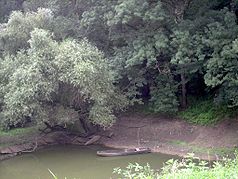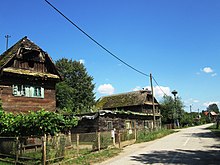Lonjsko Polje Nature Park
| Lonjsko Polje Nature Park | ||
|---|---|---|
| Lonjsko Polje | ||
|
|
||
| Location: | Sisak-Moslavina , Brod-Posavina , Croatia | |
| Specialty: | One of the largest and best preserved wetlands in Europe | |
| Next city: | Sisak , Nova Gradiška and Slavonski Brod | |
| Surface: | 506 km² | |
| Founding: | 1998 | |
| Visitors: | unknown | |
| Address: |
www.pp-lonjsko-polje.hr HR-Čigoć 26 |
|
The Lonjsko Polje Nature Park is located in northern Croatia and is one of the largest and best preserved wetlands in Europe along the Sava River between the towns of Sisak and Nova Gradiška . The area with an area of 50,600 hectares was placed under protection as a nature park in 1998 and represents the core area of the Sava floodplains for nature conservation. The area of the nature park is 50,650 hectares. The nature park consists of extensive oak forests , great diversity of birds, there are particularly many storks here. It forms the largest protected flood plain in the entire Danube catchment area. The Sava forms the southern park boundary. 239 species of birds live in this nature park, including spoonbills, sea eagles and spotted eagles. The hat pastures are an important feeding area for migratory birds.
In spring and autumn most of the area is flooded by the Save. Floods last an average of 30 to 100 days a year. Responsible for this is the flood dynamics of the tributaries of the Save, Lonja, Pakra, Great and Small Strug and Una. Strong flood waves coming from the Alps raise the water level of the Sava by up to 10 m.
Settlements
Due to the number of around 45 stork nests, the village of Čigoč , which is located in the nature park, was the first European village to receive the " European stork village" award from the Euronatur environmental foundation in 1994 .
The village of Krapje is the only village in Croatia that is protected as a monument. The village still has its original structure as a street village and like Čigoč still has a large number of houses in the typical wooden construction. The houses are made entirely of wood, two-story with small canopies for the ground floor. The staircase is on the outside, in response to the regular flooding. In this way, the boat that is ready for this can be easily reached from the first floor even during high tide. There is no living on the ground floor, only storage. The houses survived the numerous floods because they were built of holm oak . In Krapje there are also numerous public buildings in their original state: the church, the rectory, the town hall and a mill. There is a nature park center in both Čigoč and Krapje. Both were carefully integrated into existing or appropriately relocated (Krapje) houses.
Farm animals
Three regions of autochthonous livestock species overlap in the saveau :
Posavin horses , the Posavian crested chicken and Turopolje pigs. The Turopolje pigs can swim well and are therefore well adapted to the frequent floods.
Significance and danger
As a resting and breeding area, the Lonskje Polje Nature Park is of European importance for bird protection. The number of species and the number of individuals in amphibians is almost unprecedented in Europe. The saveau can hold back large amounts of water and are therefore of great importance in flood protection for those lying below. The area is threatened by the planned construction of a canal. For years, EuroNatur has been working in cooperation with the Croatian Forest Society and the Croatian Bird and Nature Conservation Association to avert the construction of the Danube-Sava Canal through consistent political lobbying. But the plans are still not finally off the table. EuroNatur criticizes the planned construction of the Danube-Sava Canal in Croatia as a gigantic destruction of nature. The structure should run from Vukovar on the Danube to Samac on the Save. The construction of the canal would affect over 3000 hectares of arable land, forests and rivers, important floodplain areas and 185 buildings. The canal is to be 61.4 kilometers long and would devour a total of around 600 million euros.
Web links
- European stork village 1994 - Čigoč, Croatia
- www.robertlesjr.from.hr - Autochthonous horse breed in Lonjsko Polje
- Homepage of the nature park: http://www.pp-lonjsko-polje.hr/new/english/kulturna_bastina_Krapje_en.html
Individual evidence
- ↑ Lonjsko Polje Nature Park Administration (ed.): Turisticka Karta . 2007.
- ↑ Vronika Wengert: Gigantic canal project to connect the Danube and the Sava. Retrieved September 14, 2017 .








